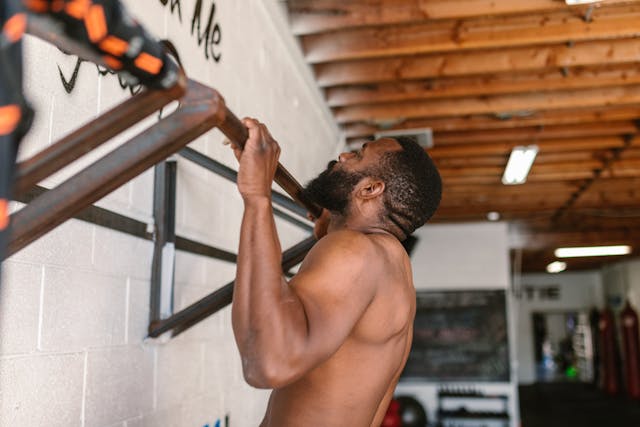Chinning up is more than just a workout; it’s a lifestyle movement that builds strength, endurance, and confidence. Whether you’re a beginner exploring assisted pull-ups with weight or an advanced fitness enthusiast mastering wide grip chinups, this exercise is a staple in strength training routines worldwide. Let’s dive into everything you need to know about chinning up, from its benefits and variations to tips for mastering the move.
Introduction: Why Chinning Up Is a Game-Changer
Chinning up is one of the most effective exercises for building upper body strength, targeting muscles like the biceps, lats, and shoulders. This timeless workout is simple yet powerful, offering countless benefits for individuals of all fitness levels. Unlike other exercises, chinning up doesn’t require fancy equipment—just a sturdy pull-up bar and determination.
If you’ve ever wondered whether chinning-up can help you achieve your fitness goals, the answer is a resounding yes. From improving posture to increasing core strength, the benefits of chinning up extend far beyond aesthetics. Whether you’re focused on chinups for biceps or exploring variations like the neutral grip chinup, this guide will equip you with everything you need to elevate your training game.
The Science Behind Chinning Up
Chinning up primarily targets the upper body, engaging muscles like the biceps, lats, traps, and even the core. When performed correctly, chinning up works as a compound movement, activating multiple muscle groups in one fluid motion. This makes it one of the most efficient exercises for strength development.
The mechanics of pullups and chinups differ slightly. A chinup uses an underhand grip, focusing more on the biceps, while a pullup engages the back muscles with an overhand grip. Both variations, including the chinup pullup combo, are essential for a well-rounded workout routine.
Chinning-Up vs. Pullups: Key Differences
While often used interchangeably, chinning up and pullups are distinct exercises with unique benefits. Chinning up employs an underhand grip, which shifts the emphasis toward the biceps and forearms. In contrast, pullups use an overhand grip to target the lats and shoulders.
For beginners, starting with chinning up is recommended, as it is generally easier to perform. Advanced fitness enthusiasts can incorporate wide grip chinups and pullup chinning for added variety and intensity. Both exercises are excellent for developing upper body strength, and combining them ensures balanced muscle growth.
Mastering Assisted Pull-Ups for Beginners
If you’re new to chinning-up, assisted pull-ups with weight are a great way to build strength gradually. Resistance bands or machines can reduce the load, making it easier to perform the movement. As your strength improves, you can reduce assistance and progress to bodyweight chinups.
Pull ups on a bar may seem intimidating at first, but consistency is key. Focus on proper form, keeping your core engaged and avoiding swinging. Whether you’re performing assisted pull-ups or neutral grip chinups, steady progress will lead to long-term success.
Variations of Chinning Up
- Neutral Grip Chinup: This variation places less strain on the wrists while still targeting the biceps and lats.
- Wide Grip Chinup: Perfect for enhancing back width and strength.
- Chinup Pullup Combo: Combines the benefits of both exercises in one workout.
- Underhand Grip Pull Ups: Focused on biceps engagement for added arm strength.
Incorporating these variations into your routine keeps your workouts challenging and effective.
Chinning Up for Biceps and Beyond
Chinups for biceps are particularly effective due to the underhand grip, which isolates the arms while still engaging the back. This makes chinning up a superior exercise compared to curls or isolation movements.
However, the benefits of chinning-up extend beyond arm strength. This exercise also improves grip strength, core stability, and overall athletic performance. Whether you’re aiming for functional fitness or aesthetics, chinning up delivers results.
Pull Up Chinning and Core Activation
Pull up chinning is not just about arm and back strength; it’s also a fantastic core workout. Keeping your core engaged during the movement stabilizes your body and prevents swinging. Advanced variations like the L-sit chinup further emphasize core activation, making chinning up a full-body exercise.
Adding core-focused pullup variations to your routine enhances functional strength and improves posture, reducing the risk of injury in other activities.
Chinning Up for Women: Breaking Stereotypes
Women often shy away from chinning-up, assuming it’s too challenging. However, with consistent practice and proper guidance, women can master this empowering exercise. Assisted pull-ups with weight are an excellent starting point, gradually building the strength needed for unassisted chinups.
Chinning-up not only tones the upper body but also boosts confidence. By incorporating this exercise into their routines, women can shatter stereotypes and redefine their fitness goals.
Tips for Chinning Up Success
- Consistency is Key: Regular practice is essential for progress.
- Focus on Form: Proper technique ensures maximum effectiveness and reduces the risk of injury.
- Incorporate Variations: Mix up your routine with wide grip chinups, neutral grip chinups, and more.
- Stay Patient: Progress takes time, so celebrate small victories along the way.
Whether you’re mastering pullups on a bar or transitioning to advanced variations, these tips will set you up for success.
The Mental Benefits of Chinning Up
Chinning-up isn’t just a physical workout; it’s a mental challenge that builds discipline, resilience, and confidence. Overcoming the initial difficulty of pull up chinning can boost your self-esteem and inspire you to tackle other challenges in life.
As you progress, the sense of accomplishment that comes with mastering chinning up becomes a powerful motivator. This mental fortitude translates into other aspects of life, proving that fitness is as much about mindset as it is about strength.
Conclusion: Why Chinning Up Should Be in Your Routine
Chinning-up is a versatile, effective exercise that builds upper body strength, enhances core stability, and boosts mental resilience. From chinups for biceps to advanced pullup chinning variations, this movement offers something for everyone.
Whether you’re a beginner or a seasoned athlete, incorporating chinning up into your routine guarantees long-term benefits. By embracing this timeless exercise, you’re not just building muscle—you’re building character and confidence. So, grab a pull-up bar, start chinning up, and unlock your true potential.

Share this:
- Click to share on Facebook (Opens in new window) Facebook
- Click to share on X (Opens in new window) X
- Click to share on LinkedIn (Opens in new window) LinkedIn
- Click to share on Reddit (Opens in new window) Reddit
- Click to share on X (Opens in new window) X
- Click to share on Threads (Opens in new window) Threads
- Click to share on WhatsApp (Opens in new window) WhatsApp




